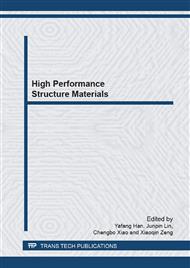p.198
p.204
p.211
p.217
p.223
p.230
p.238
p.245
p.251
Effect of Rolling Reduction on Microstructure and Mechanical Properties of Mg-9Gd-3Y-0.5Zr Alloys
Abstract:
Rolling processing has been carried out on samples cut from the extruded Mg-9Gd-3Y-0.5Zr seamless tubes. Effects of rolling reduction, 5%, 20% and 70% per pass, on its microstructure and mechanical properties were investigated. The results showed that the strength and ductility varied with increasing rolling passes at different rolling reduction. The strength of the alloy rolled by 5% reduction per pass gradually improved with increasing rolling passes, and its ductility remained basically constant. However, when 20% reduction per pass was applied, the strength and ductility of the alloy after rolling increased at first and then decreased a little after the accumulative strain higher than 52%. Moreover, as reduction reached 70% per pass, macro-cracks were induced when rolling at 420°C, while the samples were rolled at a high temperature of 500°C and a larger reduction of 70% per pass exhibited the mechanical properties comparable to those fabricated by 5% and 20% reduction. This indicated that a relatively higher productivity via rolling as well adequate mechanical properties can reach for the large scale of industrial products.
Info:
Periodical:
Pages:
223-229
Citation:
Online since:
February 2013
Authors:
Keywords:
Price:
Сopyright:
© 2013 Trans Tech Publications Ltd. All Rights Reserved
Share:
Citation:


